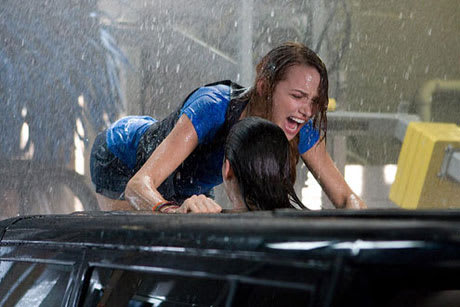If the phoney intelligentsia over at Criterion dared denigrate their image by watching Final Destination 5, they might claim it was a brilliant work of minimalist repetition. The film is so lethargic in its redundancy and disdainful of its audience that it makes no effort to be anything other than a shell for exceedingly ridiculous and grotesque death scenes.
It's rare that a movie is so self-conscious and indifferent to its badness that it actually inverts itself and starts repeating scenes of dialogue and character reaction simply because there's no point in pretending anyone might care about potential variations on a derivative formula. In fact, it could be argued that the contempt for audience expectations in franchise entertainment demonstrated here is merely a patronizing, rage-fuelled rant about having to create a vacuous work of human depravity for a culture genuinely proud of their collective lack of discernment.
To clarify, this instalment of Final Destination opens in the usual fashion with an extensive, protracted, large-scale accident killing a group of camera-friendly youths in an elaborate manner. Having covered plane crashes, highway accidents, a roller coaster disaster and a NASCAR catastrophe, part five utilizes a bridge collapse. Of course, prior to the accident, a premonition ultimately saves some lives, inadvertently pissing off Death, which creatively comes after them one by one.
Now, in previous instalments, this construct had some sense of propulsion and a visual trajectory keeping tension and hilarity at a high. Even the first and third films, which were decidedly spookier and more atmospheric than campy, maintained a respectable cinematic aesthetic that suggested the filmmakers were actually thinking about what they were doing.
Here, Steven Quale handles the material with absolutely no vision and a seeming lack of interest. After someone dies, the two main characters ― Sam and Molly (Nicolas D'Agosto and Emma Bell) ― talk about their superficial relationship, which is then followed up with a funeral scene where the dwindling group of survivors discuss Candyman's (Tony Todd) theory on Death's design. Then, someone is killed by acupuncture or a laser and this pattern is repeated five or six times until the flimsy runtime has fulfilled its obligations.
While the death scenes, which are still shocking, but far less creative and amusing than previous outings, are handled with some sort of tension (the bridge scene is quite entertaining, if weirdly clinical), everything else feels like it was rushed into a single day of production. The dialogue and acting are atrocious, which is exacerbated by the fact that every scene is handled with the same flat, uninvolved, shot-reverse-shot construct utilized on daytime talk shows.
It's as though every moment is so resigned to its purposelessness that no one involved could muster up the energy to pretend to care, which begs the question: "Why should we then?"
(Warner)It's rare that a movie is so self-conscious and indifferent to its badness that it actually inverts itself and starts repeating scenes of dialogue and character reaction simply because there's no point in pretending anyone might care about potential variations on a derivative formula. In fact, it could be argued that the contempt for audience expectations in franchise entertainment demonstrated here is merely a patronizing, rage-fuelled rant about having to create a vacuous work of human depravity for a culture genuinely proud of their collective lack of discernment.
To clarify, this instalment of Final Destination opens in the usual fashion with an extensive, protracted, large-scale accident killing a group of camera-friendly youths in an elaborate manner. Having covered plane crashes, highway accidents, a roller coaster disaster and a NASCAR catastrophe, part five utilizes a bridge collapse. Of course, prior to the accident, a premonition ultimately saves some lives, inadvertently pissing off Death, which creatively comes after them one by one.
Now, in previous instalments, this construct had some sense of propulsion and a visual trajectory keeping tension and hilarity at a high. Even the first and third films, which were decidedly spookier and more atmospheric than campy, maintained a respectable cinematic aesthetic that suggested the filmmakers were actually thinking about what they were doing.
Here, Steven Quale handles the material with absolutely no vision and a seeming lack of interest. After someone dies, the two main characters ― Sam and Molly (Nicolas D'Agosto and Emma Bell) ― talk about their superficial relationship, which is then followed up with a funeral scene where the dwindling group of survivors discuss Candyman's (Tony Todd) theory on Death's design. Then, someone is killed by acupuncture or a laser and this pattern is repeated five or six times until the flimsy runtime has fulfilled its obligations.
While the death scenes, which are still shocking, but far less creative and amusing than previous outings, are handled with some sort of tension (the bridge scene is quite entertaining, if weirdly clinical), everything else feels like it was rushed into a single day of production. The dialogue and acting are atrocious, which is exacerbated by the fact that every scene is handled with the same flat, uninvolved, shot-reverse-shot construct utilized on daytime talk shows.
It's as though every moment is so resigned to its purposelessness that no one involved could muster up the energy to pretend to care, which begs the question: "Why should we then?"
